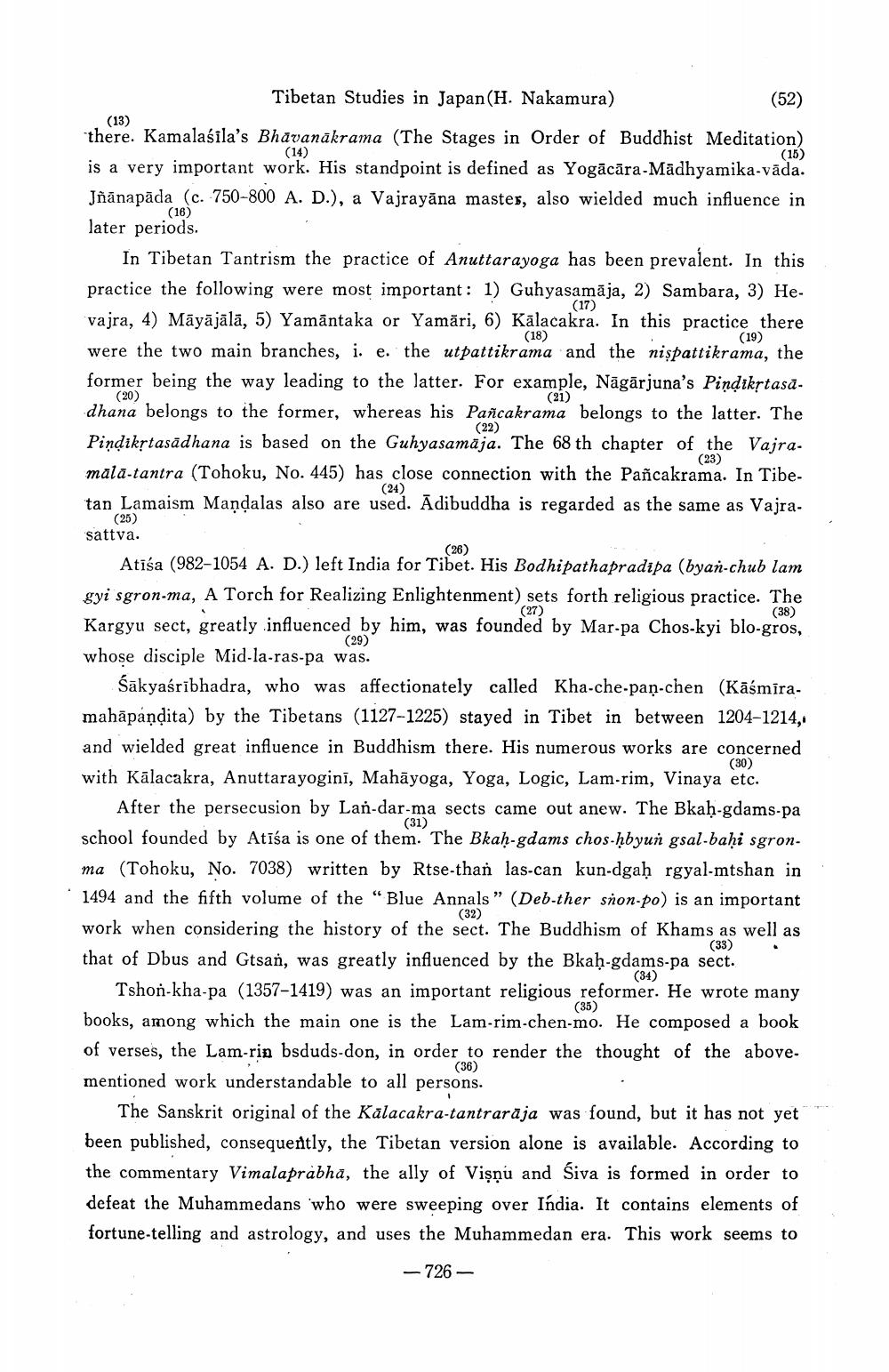Book Title: Tibetan Studies In Jjapan Author(s): Hajime Nakamura Publisher: Hajime Nakamura View full book textPage 7
________________ (16) (19) (21) (24) (27) (38) (29) Tibetan Studies in Japan (H. Nakamura) (52) (13) there. Kamalasila's Bhāvanākrama (The Stages in Order of Buddhist Meditation) (14) (15) is a very important work. His standpoint is defined as Yogācāra-Madhyamika-vāda. Jūānapāda (c. 750-800 A. D.), a Vajrayāna master, also wielded much influence in later periods. In Tibetan Tantrism the practice of Anuttarayoga has been prevalent. In this practice the following were most important: 1) Guhyasamāja, 2) Sambara, 3) He (17) vajra, 4) Māyājālā, 5) Yamāntaka or Yamāri, 6) Kālacakra. In this practice there (18) were the two main branches, i. e. the utpattikrama and the nișpattikrama, the former being the way leading to the latter. For example, Nāgārjuna's Pindıkstasa (20) dhana belongs to the former, whereas his Pancakrama belongs to the latter. The (22) Piņņikstasādhana is based on the Guhyasamāja. The 68 th chapter of the Vajra. mala-tantra (Tohoku, No. 445) has close connection with the Pancakrama. In Tibetan Lamaism Mandalas also are used. Ādibuddha is regarded as the same as Vajra (25) sattva. (26) Atīša (982–1054 A. D.) left India for Tibet. His Bodhipathapradipa (byan-chub lam gyi sgron-ma, A Torch for Realizing Enlightenment) sets forth religious practice. The Kargyu sect, greatly influenced by him, was founded by Mar-pa Chos-kyi blo-gros, whose disciple Mid-la-ras-pa was. Sākyasribhadra, who was affectionately called Kha-che-pan-chen (Kāśmira. mahāpaņdita) by the Tibetans (1127-1225) stayed in Tibet in between 1204-1214, and wielded great influence in Buddhism there. His numerous works are concerned with Kālacakra, Anuttarayoginī, Mahāyoga, Yoga, Logic, Lam-rim, Vinaya etc. After the persecusion by Lan-dar-ma sects came out anew. The Bkah-gdams-pa school founded by Atīsa is one of them. The Bkah-gdams chos-hbyun gsal-baħi sgronma (Tohoku, No. 7038) written by Rtse-than las-can kun-dgaḥ rgyal-mtshan in 1494 and the fifth volume of the "Blue Annals” (Deb-ther snon-po) is an important work when considering the history of the sect. The Buddhism of Khams as well as that of Dbus and Gtsan, was greatly influenced by the Bkah-gdams-pa sect. Tshon-kha-pa (1357-1419) was an important religious reformer. He wrote many books, among which the main one is the Lam-rim-chen-mo. He composed a book of verses, the Lam-rin bsduds-don, in order to render the thought of the abovementioned work understandable to all persons. The Sanskrit original of the Kālacakra-tantraraja was found, but it has not yet been published, consequently, the Tibetan version alone is available. According to the commentary Vimalaprabha, the ally of Vişnu and Siva is formed in order to defeat the Muhammedans 'who were sweeping over India. It contains elements of fortune-telling and astrology, and uses the Muhammedan era. This work seems to - 726 – (30) (31) (32) (33) (34) (35) (36)Page Navigation
1 ... 5 6 7 8 9 10 11 12
